Getting the Mars Science Laboratory to the Red Planet isn’t as easy as just strapping the rover on an Atlas V rocket and blasting it in the general direction of Mars. Spacecraft navigation is a very precise and constant science, and in simplest terms, it entails determining where the spacecraft is at all times and keeping it on course to the desired destination.
And, says MSL navigation team chief Tomas Martin-Mur, the only way to accurately get the Curiosity rover to Mars is for the spacecraft to constantly be looking in the rearview mirror at Earth.
“What we do is ‘drive’ the spacecraft using data from the Deep Space Network,” Martin–Mur told Universe Today. “If you think about it, we never see Mars. We don’t have an optical navigation camera or any other instruments to be able to see or sense Mars. We are heading to Mars, all the while looking back to Earth, and with measurements from the Earth we are able to get to Mars with a very high accuracy.”
This high accuracy is very important because MSL is using a new entry, descent and landing guidance system which will allow the spacecraft to land more precisely than any previous landers or rovers.
“It is very challenging, and even though it is something similar to what we have done before with the Mars Exploration Rover (MER) mission, this time it will be done at an even higher level of precision,” Martin-Mur said. “That allows us to get to a very exciting place, Gale Crater.”
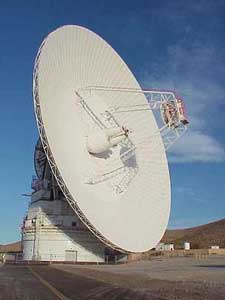
On Earth, we constantly can find exactly where we are with GPS – which is on our cell phones and navigation equipment. But there is no GPS at Mars, so the only way the rover will be able to head to –and through — a precise point in the Red Planet’s atmosphere is for the navigation team to know exactly where the spacecraft is and for them to keep telling the spacecraft exactly where it is. They use the Deep Space Network (DSN) for those determinations from launch, all the way to Mars.
The Deep Space Network consists of a network of extremely sensitive deep space communications antennas at three locations: Goldstone, California; Madrid, Spain; and Canberra, Australia. The strategic placement approximately 120 degrees apart on Earth’s surface allows constant observation of spacecraft as the Earth rotates.
But of course, it’s not as easy as just getting the rocket from Point A to Point B since Earth and Mars are not fixed positions in space. Navigators must meet the challenges of calculating the exact speeds and orientations of a rotating Earth, a rotating Mars, as well as a moving, spinning spacecraft, while all are simultaneously traveling in their own orbits around the Sun.
There are other factors like solar radiation pressure and thruster firings that all have to be precisely calculated.
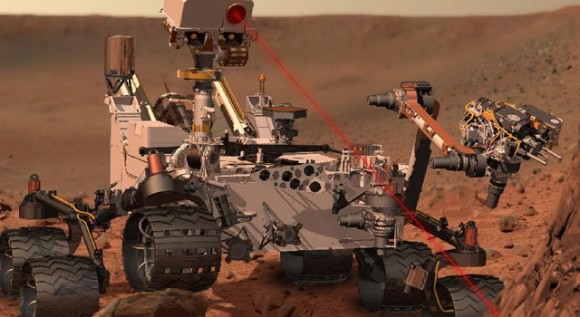
Martin-Mur said even though MSL is a much bigger rover with a bigger spacecraft and backshell than the MER mission, the navigation tools and calculations aren’t much different. And in some ways, navigating MSL might be easier.
“The Atlas V vehicle provides a much more precise launching and can put us in a more precise path than the MER, which used a Delta II,’ Martin-Mur said. “This allows us to use less propellant, proportionally per pound, to get to Mars than the MER rovers did.”
The MER rovers and spacecraft weighed about 1 ton, while MSL weighs almost 4 tons. MSL is allotted 70 kg of propellant for the cruise stage, while the MER rovers each used about 42 kg of propellant.
Interestingly, for the MSL spacecraft to descend through Mars’ atmosphere and land, the spacecraft will use about 400 kg of propellant.
Additionally, Martin-Mur said more precise planetary ephemeris and Very Long Baseline Interferometry measurements are available, enabling the navigation to be able to deliver the spacecraft to the right place in the atmospheric entry interface, so the vehicle finds itself in the range of parameters that it has been designed to operate.
Navigation at Launch
It all starts with years of preparations and calculations by the navigation team, which must calculate all the possible trajectories to Mars depending on exactly when the Atlas V rocket launches with MSL aboard.
In some cases there are literally thousands of launch opportunities and all the possible trajectories must be calculated precisely. The Juno mission, for example, had two-hour daily launch windows with 3,300 possible launch opportunities. For MSL the daily launch windows contain liftoff opportunities in 5 minutes increments. Across the 24 day launch period the team has calculated 489 different trajectories for all the possible launch opportunities.
But ultimately, they will end up using only one.
“This is not something you do on the fly – you prepare all this well in advance so you have time to sit back and assess it and check it,” said another member of the MSL navigation team, Neil Mottinger, who has worked at the Jet Propulsion Laboratory since 1967. He’s worked on navigation for many missions like Mariner, Voyager, the MER, and several international missions.
“The initial function of navigation at launch is to determine the actual spacecraft trajectory well enough so the spacecraft signal will be well within the beam-width of the DSN antennae,” Mottinger told Universe Today.
The Mars Science Laboratory will separate from the rocket that boosted it toward Mars at about 44 minutes after launch, with the navigator’s tracking the spacecraft’s every move.
Mottinger added that without the DSN’s communication capabilities, there are no planetary missions. “The Navigation team does whatever it can to make sure there aren’t any gaps in communication,” he said. “It’s crunch time during the first 6-8 hours after launch to be able to determine the exact position of the spacecraft.”
From the recent problems with the Phobos-Grunt mission, it is evident how difficult it is to track and communicate with a just-launched spacecraft.
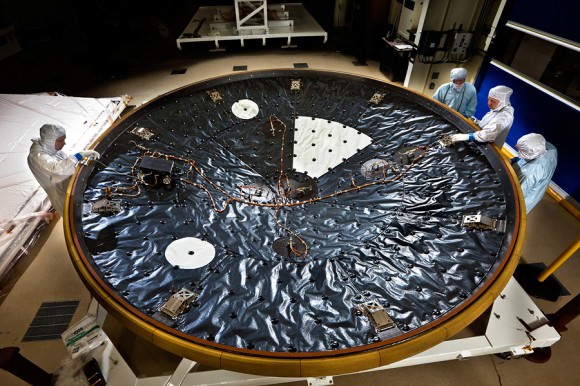
Mid-course Corrections
Again, the navigation team has modeled and calculated all the maneuvers and thruster burns for the mission. Once MSL is on its way to Mars, the navigation team will revisit all their models and design the maneuvers to take the spacecraft to the right entry interface at Mars.
“We’ll keep doing orbit determination and re-designing the maneuvers for the spacecraft,” said Martin-Mur. “MSL has 1 lb thrusters – the same size as the MER spacecraft — but our spacecraft is almost four times heavier so the maneuvers we do take a long time – some will take hours.”
For interplanetary navigation, the engineers use distant quasars as landmarks in space for reference of where the spacecraft is. Quasars are incredibly bright, but are at such colossal distances that they don’t move in the sky like nearer background stars do. Martin-Mur provided a list of nearly 100 different quasars that could be used for this purpose, depending on where the spacecraft is.
“It is interesting,” Martin-Mur mused, “with quasars we are using something that is billions of light years away from us, from the very early universe, which are so old that they might not even be there anymore. It is really cool that we are using an object that currently may not exist anymore, but using them for very precise navigation.”
The navigation team also needs to model the solar radiation pressure – the effect the Sun’s radiation has on the spacecraft.
“We know very well, thanks to our friends from the Solar Systems Dynamics group, where Mars is going to be and where the Earth and Sun are,” said Martin-Mur. “But since this spacecraft has not been in space before, what is not known precisely is how solar radiation pressure will affect the surface properties of the spacecraft, and how it will perturb the spacecraft. If we don’t have a good model for that, we could be hundreds of kilometers off as the spacecraft goes from Earth to Mars.”
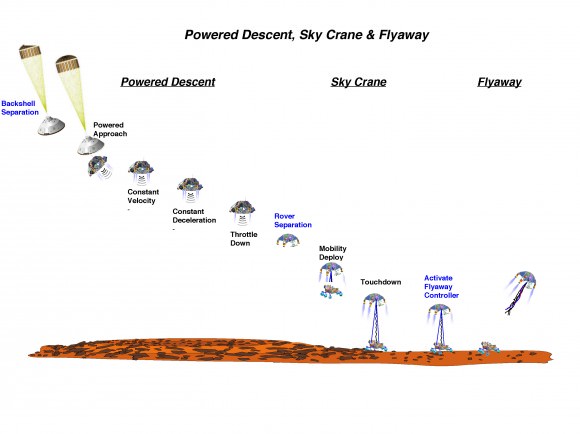
Arriving at Mars
As the spacecraft approaches Mars, it is very important to know precisely where the spacecraft is. “We need to target the spacecraft to the right entry point,” said Martin-Mur, “and tell the spacecraft where it will enter, so it will be able to find its way to the landing site.”
The MSL Entry Descent and Landing Instrumentation, or MEDLI, will stream information back to Earth as the probe enters the atmosphere, letting the navigators — and the science team – know precisely where the rover has landed.
Only then will the navigation team be able — maybe — to breathe a sigh of relief.

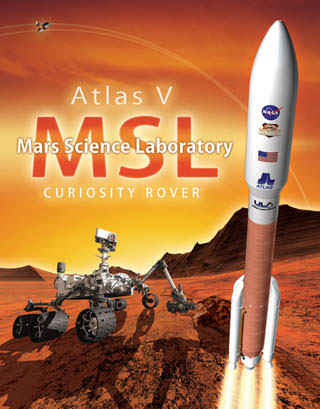
This pending voyage of the Science vessel “Curiosity”, about to raise anchor for a distant shore, is a quantum leap from the wooden deck of old ships of sail, in enterprise of discovery to new lands to explore.
A fascinating look into the complex details of what is involved in “steering” a spacecraft from port Earth, through launch window of favorable “tides”, and through a journey’s course corrections before Solar Winds in space, to a successful harbor-site entry, upon arrival at another world (one veiled in intriguing mysteries, and beckoning from afar with challenging possibilities).
“It is interesting, with quasars we are using something that is billions of light years away from us, from the very early universe, which are so old that they might not even be there anymore. It is really cool that we are using an object that currently may not exist anymore, but using them for very precise navigation.” — MSL navigation team chief Tomas Martin-Mur
Anciently, the North Star was one guide of a sailor’s navigated way to his destination of maritime passage; now, it appears (though may have disappeared), phantom “stars”, distant in time’s early light, serve to orient real-time automated crossings through open seas of planetary night.
Marvelous!
It sounds like you might enjoy (or maybe have enjoyed ;)) Voyager: Seeking Newer Worlds in the Third Great Age of Discovery by Stephen J. Pyne.
He does an excellent job of making almost every aspect of the Voyager mission (and each leg of its journey) a metaphor for some similar aspect of that Age. The book is as much about what caused and enabled the Age of Discovery as it is about the science and technology of the Voyager mission.
It was not at all what I expected – but was a brilliant read in its own right. As someone who is usually completely ignorant of history, I found it very enlightening.
Hello. Actually, I have not read the book, though I have long been fascinated by Western Man’s Great Age of Exploration. It does sound interesting. The “Three Ages of Exploration” is a somewhat new concept for me: Renaissance, Enlightenment, and in our time, the Space Age. From oceans crossed to lands explored, then, with accomplished global reach, out into continental realms of ice, and down to Inner Space of ocean depths. Now, we venture into Outer Space through interplanetary “voyages”. As the first two Ages changed our sense of place on Earth, so the “Third Age” of the robotic seafarers has “changed our sense of … place in the universe.” — Book description at Amazon.
(Thanks for the suggested reading.)
“Voyager may be one of the purest expressions of exploration in human history.”
Wow, quite well put! Your analogue to the great virgin days of transoceanic sailing really captures the isolated sense of the vastness of far flung fairing (be it sea or space) that I was feeling as I read Nancy’s article! What a lonely yet highly scrutinized trek the dear lass has to her next port…
Lets hope a fair wind brings her to a soft landfall on a scenic shore of red sand.
Wow, at this point I cannot even imagine how tricky the navigation of interstellar probe would be, especially when it would be dealing with relativistic speed.
The landing system as conceived appears quite complicated… I wonder why it takes 10 steps from final orbit to land? Anyone, can you let me into the reasons for this?
Briefly, in haste:
– I think you will find 5 more EDL steps from orbit in the Curiosity video before the descent image here. With: entry burn; initial entry attitude; release of weights to adjust attitude; rocket assisted descent attitude; another weight release for chute attitude; [release of the chute and so on].
– An article (here on UT, I believe) describes this as the generic ED approach developed for Viking.
— The supersonic chute was costly to develop with many iterations of rocket tests. They seem to know how to scale it for different loads.
— The heat shield and backshell profile is a fairly generic development for the Mars atmosphere as well, I take it.
— Presumably the added precision comes from knowing Mars atmosphere better and a better control of the rockets during the descent stages.
– The new bit of landing (L) starts with the rover separation. From the massive Viking rocket descent to earlier lighter rovers balloon bouncing, the mass was up to Viking class again. Hence rockets.
It would seem that a four satellite “bare bones” GPS system could be placed around some of the planets. In particular Mars and Jupiter, where with Jupiter it could double as a set of tests for general relativity. A spacecraft which reaches the environs of a planet could be guided in for a pinpoint orbital insertion or landing.
LC
That suddenly makes me think of a question – how do the GPS satellites themselves determine their exact position? Do they use each other or do they use ground-based beacons?
In two dimensions the surveyor needs two theodolites at a known distance from each other to measure a third point. So you need two instruments to measure the relative position of a third point. If one is to measure the distance to a point relative to other points in three dimensional space you need three instrument. Again you need some ruler system which sets the distance between the three instruments. Similarly, in spacetime you need four. The baseline distances are determined by laser or EM radiation ranging.
LC
Sending MLS across space to a tiny window at Mars during a once-in-a-hundred-years, Carrington effect, solar storm is probably going to be a waste of taxpayer money. Coronal mass ejections are certain to occur and likely to damage the fragile sensors and computers on MLS and there is a high probablility they will damage the electronics in satellites and earthbound computers, or at least damage the grid. Yet the mission is going on. Why?
MLS is already old technology with a Russian hitchhiker. It is seeking to prove what we already know. And MLS is already two years past the target launch date. The devoted scientists — actually geologists for the most part — who designed the experiments back in 2005 could not justify sending these outdated experiments, on a subsequent mission.
I hope I am wrong. You will get a chance to see when you read the book Dr. Gilbert Levin and I have written about the 60 year search for life on Mars.
Rick Eyerdam
Minor nitpick: are geologists not scientists?
Huge applause from Australia #CSIROTweetup when the clock started to count down for #MSL. We are at the Canberra Deep Space Tracking Station and will follow the rocket track on its path over Australia.